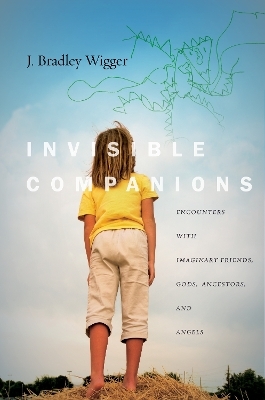
Invisible Companions
Stanford University Press (Verlag)
978-1-5036-0911-2 (ISBN)
From the US to Nepal, author J. Bradley Wigger travels five countries on three continents to hear children describe their invisible friends—one-hundred-year-old robins and blue dogs, dinosaurs and teapots, pretend families and shape-shifting aliens—companions springing from the deep well of childhood imagination. Drawing on these interviews, as well as a new wave of developmental research, he finds a fluid and flexible quality to the imaginative mind that is central to learning, co-operation, and paradoxically, to real-world rationality. Yet Wigger steps beyond psychological territory to explore the religious significance of the kind of mind that develops relationships with invisible beings. Alongside Cinderella the blue dog, Quack-Quack the duck, and Dino the dinosaur are angels, ancestors, spirits, and gods. What he uncovers is a profound capacity in the religious imagination to see through the surface of reality to more than meets the eye. Punctuated throughout by children's colorful drawings of their see-through interlocutors, the book is highly engaging and alternately endearing, moving, and humorous. Not just for parents or for those who work with children, Invisible Companions will appeal to anyone interested in our mind's creative and spiritual possibilities.
J. Bradley Wigger teaches religious education and childhood studies at Louisville Seminary. An ordained Presbyterian minister and a recent Henry Luce III Fellow in Theology, Dr. Wigger has served churches in Colorado, Wisconsin, and Mexico. His most recent publications are the picture book for children, Thank You, God (2014), and Original Knowing: How Religion, Science, and the Human Mind Point to the Irreducible Depth of Life (2012).
Contents and AbstractsIntroduction: See-through Knowing chapter abstractThe book opens with the author, twenty years earlier, discovering his daughter has an imaginary friend, Crystal. The scene brings together the origins of his interest in invisible friends (IFs) as both personal and professional. Wonder and curiosity forge the motivation driving the research and book: Why do children make up such companions? And beneath this psychological question is a religious one: Is there a connection between a relationship to an invisible friend and one to an invisible God? The notion of "see-through knowing" is inspired by the name Crystal, which, like the glass, is see-through. The narrative style of the chapter introduces the style of the entire book, which itself is inspired by the children it presents, based upon firsthand interviews. Children take in the world around them and create scenes and characters much as novelists (or narrative nonfiction writers) do.
1Life-Givers chapter abstractThe chapter immediately jumps into descriptions of IFs based upon interviews with children over the course of a year: "Meet Quack Quack." It uses children's own words and drawings to highlight large themes that are explored throughout the book: play and pretense, unpredictability and flexibility, and the intensity of childhood relationships. Addressed as well are the ways the research was carried out, previous studies (which are very limited), ethical considerations, definitions of IFs, and the ways children with IFs were recruited (through parents). It draws upon a notion of saints as "life-givers" to frame the friends and the children who created them.
2Flexibility chapter abstractThe chapter presents more descriptions of IFs, focusing upon the theme of flexibility. Categories such as gender and form are less rigid among the IFs of many of the children: Jeff, a boy, is sometimes a girl, Jeffette; Dino is sometimes a dinosaur and at other times a space alien. Space and time are fluid as well: an IF is here one moment, in Florida the next; another IF is thousands of years old. Even life and death are stretched: an IF died but has returned; another went away to be with an aunt who died; another is a girl's grandfather who died but comes back to comfort her when she's sad. The chapter makes connections to a religious imagination (also not limited by death), which, in turn, sets up a discussion of the work and influence of Freud and the parallels between his view of religion and childhood imagination.
3Logic and Imagination chapter abstractThe chapter makes clear that children know the difference between their imaginary friends and "real-life" people. A prevalent fear stoked by Freud's and Piaget's assumptions about early childhood is that children with IFs may be psychologically troubled. Both believed young children were unable to differentiate fantasy from reality and the developmental task is to move from such confusion to a real-world orientation. Drawing upon a new wave of research into early childhood development, the chapter demonstrates how the Freudian/Piagetian framework got the picture wrong, backwards. Imagination is the developmental achievement and actually aids the development of logic and real-world rationality.
4Sharing chapter abstractBeginning with brothers who share an IF named Baby Bear, the chapter draws out the social dimensions of imaginative play. It provides a brief description of the evolutionary emergence and importance of the deeply social qualities of the human mind. The roots of this mind likely grow in the evolutionary soil of care-taking and food sharing; and the chapter highlights themes of sharing and eating found in the interviews (e.g., IFs eat dinner with the family). The chapter takes the notion of a deeply social mind even deeper and makes soft connections to the theme of sharing and eating in religion.
5Wild Mind chapter abstractThe chapter returns to the phenomenon of shapeshifting among some children's IFs. Lucy is a mom, a tiger, a rabbit, a mouse, and more, depending upon the day or hour. But she is still Lucy. Childhood studies of psychological "essentialism" help illumine how and why the essence of Lucy could remain even as her appearance changes. Moreover, the chapter focuses upon play itself in learning and development. When children pretend or imagine, they are "playing with mind." That is, children are playing with the points of view, motivations, and knowledge others have in order to understand the social world with more agility.
6Who Knows What? chapter abstractThe chapter builds a bridge between Parts I and II and provides a more direct discussion of religion. Not only did the author interview children about IFs, he conducted theory-of-mind cognitive tests with them. Theory of mind refers to the ways in which children (or adults) think about the knowledge others possess. "Would Quack Quack know what's in this box if nobody showed him?" The author describes the significance of this research (especially in relation to religion) through his travels and work at the University of Oxford. "Would God know what's in this box?" The results create important challenges to Piaget's theory of development. Primarily, children are not nearly as "concrete" or "egocentric" in thinking as had been thought. They easily think about a mind (like God's) who has never been encountered concretely and can differentiate such a special mind from those of ordinary (limited) humans.
7Ancestors and Angels chapter abstractThe chapter describes interviews conducted among over 300 children in Kenya and Malawi. Over 20% of the Kenyan children had IFs, and over 25% of the children in Malawi did, answering the first question: Do children in developing countries even have IFs? Lack of recreational facilities or toys did not seem to inhibit imagination. Using theory-of-mind tests, the author asked not only about an IF or Christian God in Kenya but about the ancestors and the Sun (both important to the local culture) as well. In Malawi, children were asked about the minds of spirits and angels as well as Allah (among Muslims) and God (among Christians). Results showed strong similarities between the ways children in Kenya, Malawi, and the US think about ordinary and extraordinary minds, including the minds of IFs.
8Gods and Godsibbs chapter abstractThe chapter describes interviews in Nepal (Hindu and Buddhist) and the Dominican Republic (Christian). Only 5% of Nepali children had IFs, while in the DR over a third had them. Reasons for the differences are explored, but generally there seems to be a cultural emphasis upon realism in Nepal that discourages fantasy and imagination. Nonetheless, children in this polytheistic culture tend to think of the minds of gods and goddesses in a way similar to the way children in monotheistic cultures think of God's mind. The deities know in extraordinary ways. In the DR, over a third of the children described IFs and drew pictures of them. In the DR, theory-of-mind results challenge even further Piaget's theory of childhood egocentrism. The chapter turns to evolutionary theories of gossip as a suggestive angle on IFs and our deeply social, if not religious natures.
9Original Knowing chapter abstractThe chapter explores, from an evolutionary perspective, the type of mind that can imagine, and it focuses upon the power of a "social imagination" that not only learns but intentionally teaches and cooperates, which is unique among primates. The capacity leads to "accumulated cultural learning" and the vast differences between humans and others (especially chimps) despite being so similar in DNA makeup. The chapter makes a moral point that our cognition and cooperation do not make us inherently better, but make us dangerous. The temptation is to reduce others and claim our own beliefs ultimate. Religion can do this too. But religion can also resist the temptation and stoke the ability to recognize the irreducible nature of others, the world. Religion can stoke wonder.
10Friends of God chapter abstractThe chapter opens with a friend who has imaginary conversations with his late father (over coffee). It looks at the parallels between novelists with their characters and children with IFs. But the chapter uses these to raise the big question: Are they real? This leads to the question, Is God just an imaginary friend? Some evolutionary psychologists use theory of mind to explain (away) religion. The chapter acknowledges the possible truth of the claim but also some shortcomings: one philosophical (it does not wrestle with why there is a world at all), the other psychological (it does not address the prevalence of unbelief or skepticism even among the religious). Ultimately, drawing upon Jewish mysticism, the chapter turns the question around, raising the possibility that we are God's imaginary friends, born of the Creator's imagination (like an author) for the sake of relationship.
| Erscheinungsdatum | 23.10.2018 |
|---|---|
| Reihe/Serie | Spiritual Phenomena |
| Zusatzinfo | 12 color illustrations, 15 halftones, 1 table |
| Verlagsort | Palo Alto |
| Sprache | englisch |
| Maße | 152 x 229 mm |
| Themenwelt | Geisteswissenschaften ► Psychologie ► Allgemeines / Lexika |
| Geisteswissenschaften ► Religion / Theologie | |
| Sozialwissenschaften ► Ethnologie | |
| Sozialwissenschaften ► Soziologie | |
| ISBN-10 | 1-5036-0911-1 / 1503609111 |
| ISBN-13 | 978-1-5036-0911-2 / 9781503609112 |
| Zustand | Neuware |
| Haben Sie eine Frage zum Produkt? |
aus dem Bereich


